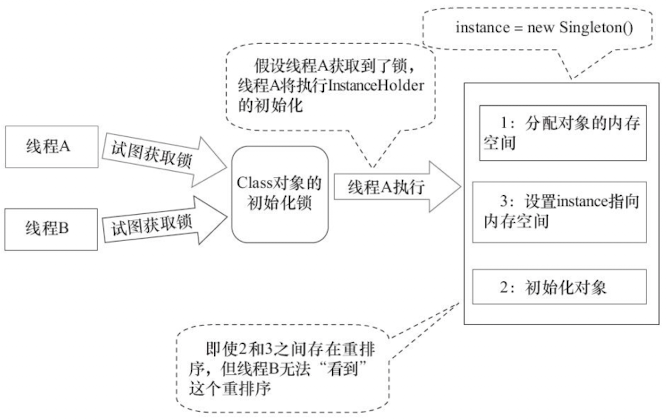许多时候整个系统只需要拥有一个的全局对象,这样有利于协调系统整体的行为。
饿汉式
在类初始化时,单例对象已经自行实例化。所以全局的单例实例在类装载时构建
public class Singleton {
private static Singleton instance = new Singleton();
// 私有构造函数,外部不可调用
private Singleton() {}
public static Singleton getInstance() {
return instance;
}
}
懒汉式
在第一次调用时,单例对象进行实例化。所以全局的单例实例在第一次被使用时构建。字段延迟初始化降低了初始化类或创建实例的开销,但增加了访问被延迟初始化的字段的开销。除非确有必要,在大多数时候,正常的初始化要优于延迟初始化。
单线程
这种方法是线程不安全的
public class Singleton {
private static Singleton instance = null;
// 私有构造函数,外部不可调用
private Singleton() {}
public static Singleton getInstance() {
if (instance == null) {
instance = new Singleton();
}
return instance;
}
}
多线程
通过双重检查锁定确保,多个线程试图在同一时间创建对象时,只有一个线程能创建对象,在对象创建好之后,不需要获取锁,直接返回已创建好的对象。
public class Singleton {
private static Singleton instance = null;
// 私有构造函数,外部不可调用
private Singleton() {}
public static Singleton getInstance() {
if (instance == null) {
synchronized (Singleton.class) {
if (instance == null) {
instance = new Singleton();
}
}
}
return instance;
}
}
以上代码存在一个问题,由于重排序可能会导致,代码读取到instance,判断不为null时,instance引用的对象有可能还没有完成初始化。
对于instance = new Singleton()来说可以分解为以下三个伪代码
memory = allocate();分配对象的内存空间ctorInstarce(memory);初始化对象instance = memory;设置instance指向刚分配的内存地址
步骤2和步骤3可能发生重排序,即instance指向刚分配的内存地址时,对象初始化没有完成。这时,如果其他线程判断了instance != null而没有获取锁直接将instance返回,那么返回的将是一个未初始化完成的对象。
双重检查锁定
使用volatile修饰instance可以阻止instance = new Singleton()语句重排序
public class Singleton {
private volatile static Singleton instance = null;
// 私有构造函数,外部不可调用
private Singleton() {
}
public static Singleton getInstance() {
if (instance == null) {
synchronized (Singleton.class) {
if (instance == null) {
instance = new Singleton();
}
}
}
return instance;
}
}
类初始化
在执行类的初始化期间,JVM会去获取一个锁。这个锁可以同步多个线程对同一个类的初始化
public class Singleton {
// 私有构造函数,外部不可调用
private Singleton() {}
public static Singleton getInstance(){
return singletonHolder.instance;
}
private static class singletonHolder{
private static Singleton instance = new Singleton();
}
}
如图所示,即使instance = new Singleton()发生重排序,也不会出现返回未完成初始化对象的情况

REFERENCE
- Java并发编程的艺术
文档信息
- 本文作者:wzx
- 本文链接:https://masterwangzx.com/2021/01/10/java-singleton/
- 版权声明:自由转载-非商用-非衍生-保持署名(创意共享3.0许可证)